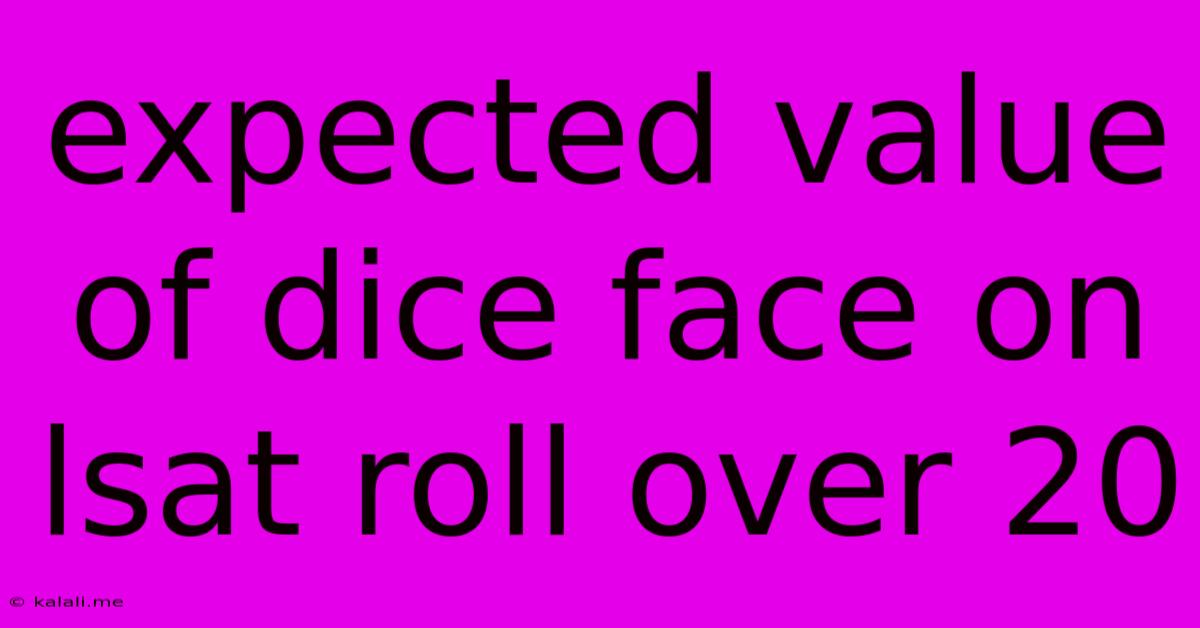Expected Value Of Dice Face On Lsat Roll Over 20
Kalali
May 23, 2025 · 3 min read

Table of Contents
Expected Value of a Dice Face on the Last Roll Over 20
This article explores the fascinating problem of calculating the expected value of a single die face on the last roll, given that you've rolled the die multiple times and only stopped when the sum of your rolls exceeds 20. This isn't a simple average; the probability of seeing a specific face on that final roll is influenced by the previous rolls. Understanding this requires delving into conditional probability and expected value calculations. We will break down the problem step-by-step to provide a clear and concise solution.
Understanding the Problem
The core challenge lies in the conditional nature of the problem. We're not just interested in the average roll of a six-sided die (which is simply 3.5). We're specifically looking at the expected value of the last roll, given the condition that the cumulative sum of all rolls just exceeded 20. This means the previous rolls played a significant role in determining the outcome of the final roll and its expected value. The probability distribution of the last roll will be skewed compared to a simple, independent roll.
Approaching the Solution
Solving this problem analytically is complex, potentially requiring intricate recursive calculations or Markov chains. However, we can employ a simulation approach using a computer program (Python is a great choice for this) to approximate the expected value. This method involves repeatedly running the experiment (rolling until the sum exceeds 20) and recording the value of the last roll. By averaging these final rolls over a large number of trials, we can get a very close approximation of the true expected value.
Python Simulation Code (Illustrative)
While we won't delve into the specifics of complex analytical solutions, here's a simplified Python code snippet to illustrate the simulation approach:
import random
def simulate_dice_rolls():
total = 0
rolls = []
while total <= 20:
roll = random.randint(1, 6)
total += roll
rolls.append(roll)
return rolls[-1] # Return the last roll
num_trials = 100000
last_rolls = [simulate_dice_rolls() for _ in range(num_trials)]
average_last_roll = sum(last_rolls) / num_trials
print(f"The approximate expected value of the last roll is: {average_last_roll}")
This code simulates the dice rolling process, and by running it with a high number of trials (e.g., 100,000), we'll obtain a reasonably accurate estimate. The result will likely be slightly greater than 3.5 because of the inherent bias; if the sum is close to 20, it's more likely the last roll is a smaller number to push the total over 20.
Expected Value and Intuition
Intuitively, one might expect the expected value to be slightly higher than 3.5. The reason is that the last roll will often be a smaller number to push the total over 20, but can sometimes be higher to go significantly over the threshold. This asymmetry pushes the expected value up.
Conclusion
Calculating the precise expected value of the last dice roll in this scenario analytically is challenging. However, using a simulation approach with a large number of trials provides a very accurate approximation. The simulation demonstrates that the expected value is slightly higher than the simple average of a die roll (3.5), reflecting the impact of the stopping condition on the probability distribution of the last roll. This problem highlights the importance of understanding conditional probability and the power of simulation techniques in tackling complex probability questions. Remember to run the simulation code yourself with a sufficient number of trials for a reliable estimate.
Latest Posts
Latest Posts
-
How Long Is A China Man Joke
Jul 05, 2025
-
What Episode Does Ichigo Get His Powers Back
Jul 05, 2025
-
Pokemon Mystery Dungeon Red Rescue Team Codes
Jul 05, 2025
-
How Much Is 25 20 Dollar Bills
Jul 05, 2025
-
How Many Apples In 3 Lb Bag
Jul 05, 2025
Related Post
Thank you for visiting our website which covers about Expected Value Of Dice Face On Lsat Roll Over 20 . We hope the information provided has been useful to you. Feel free to contact us if you have any questions or need further assistance. See you next time and don't miss to bookmark.